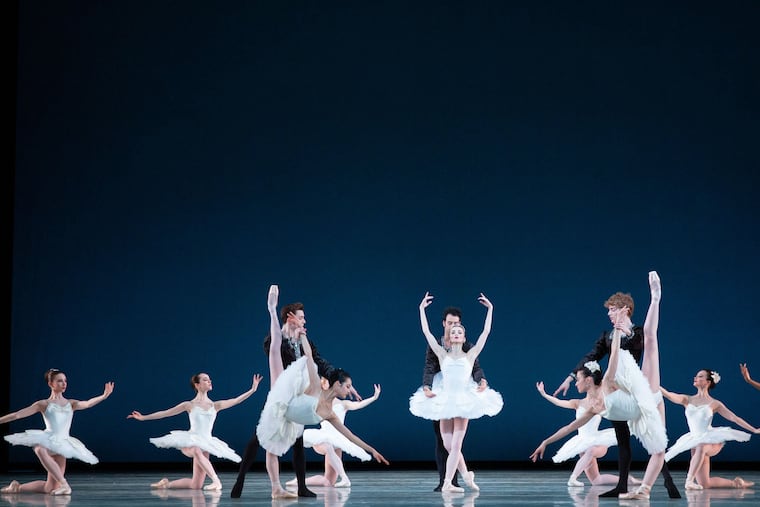Philadelphia Ballet sparkles in a revisit of its Balanchine roots
Philadelphia Ballet opened its Balanchine program Thursday night at the Academy of Music, and it positively glittered.

Nearly 60 years ago, Barbara Weisberger opened Philadelphia Ballet — until recently called Pennsylvania Ballet — with the help and encouragement of her mentor, the great choreographer George Balanchine, who founded New York City Ballet.
For most of the Philadelphia Ballet’s existence, it was known as a Balanchine company, whose repertoire heavily featured the great master’s works.
That changed when Angel Corella took over as artistic director in 2014. Corella came from American Ballet Theatre, which performs more story ballets and classical works. The Nutcracker would remain the Balanchine version, but for many seasons, the other Balanchine work seemed like an afterthought, a weaker program performed with many dancers who never trained in the Balanchine style.
Philadelphia Ballet opened its Balanchine program Thursday night at the Academy of Music, and it positively glittered.
When a company wants to perform a Balanchine ballet, it must hire a répétiteur, usually a former City Ballet dancer who the Balanchine Trust certifies to stage his work.
This time it was Colleen Neary, a City Ballet soloist in the 1970s and the artistic director of Los Angeles Ballet. She taught the entire Bold, Brilliant, Balanchine program to Philadelphia Ballet — Symphony in C, Divertimento No. 15, and Stars and Stripes. All tutu ballets and audience favorites, one was more lovely than the other, and the dancers looked crisp and precise.
The one large misstep was in the programming, not the dancing. The evening opened with a presentation honoring Black ballet dancers, including some Philadelphia Ballet alumni and Jermel Johnson, who will be retiring on May 15. But as soon as that finished, the curtain went up on Symphony in C — a so-called “white ballet,” named for the rows of dancers in white tutus, and in this case featuring only white dancers. Dancers of other races joined in the second movement, but the contrast between talk and action resulted in a cringeworthy moment.
That was a choice by the producers, not the dancers. Aside from the fact that some of the women didn’t seem to have enough room to fly in their leaps, the dancers, performing to music by Georges Bizet, all looked excellent, especially Oksana Maslova and Arian Molina Soca in the second movement and Mayara Piniero and Ashton Roxander in the third. Maslova in particular has the most beautiful feet and flexible back.
The white tutus of Symphony in C gave way to blues and greens in Divertimento No. 15, with music by Mozart and also lovely. Here, the standouts were Nayara Lopes (who was recently promoted to principal dancer) and Johnson (in one of his final performances), both especially fast and dynamic. Not all the dancers were equally adept at the speedy footwork.
The evening closed out with Stars and Stripes. Born in Russia, Balanchine was an enthusiastic immigrant who loved America and Americana. This ballet is all John Philip Sousa and red, white, and blue (with a little pink and yellow thrown in on the tutus). It is a crowd-pleasing parade of a ballet with all dancers performing sharp and clean.
The lovely couple performing as Liberty Bell and El Capitan on Thursday? Like Balanchine, an immigrant embracing every movement — Dayesi Torriente, from Cuba, along with Sterling Baca.